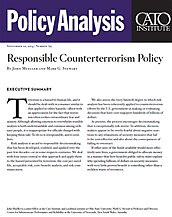Risk analysis is an aid to responsible decision making that has been developed, codified, and applied over the past few decades—or in some respects centuries. We deal with four issues central to that approach and apply them to the hazard presented by terrorism: the cost per saved life, acceptable risk, cost–benefit analysis, and risk communication. We also assess the (very limited) degree to which risk analysis has been coherently applied to counterterrorism efforts by the U.S. government in making or evaluating decisions that have cost taxpayers hundreds of billions of dollars.
At present, the process encourages decision making that is exceptionally risk averse. In addition, decision makers appear to be overly fearful about negative reactions to any relaxations of security measures that fail to be cost-effective and also about the consequences of failing to overreact.
If other uses of the funds available would more effectively save lives, a government obliged to allocate money in a manner that best benefits public safety must explain why spending billions of dollars on security measures with very little proven benefit is something other than a reckless waste of resources.



